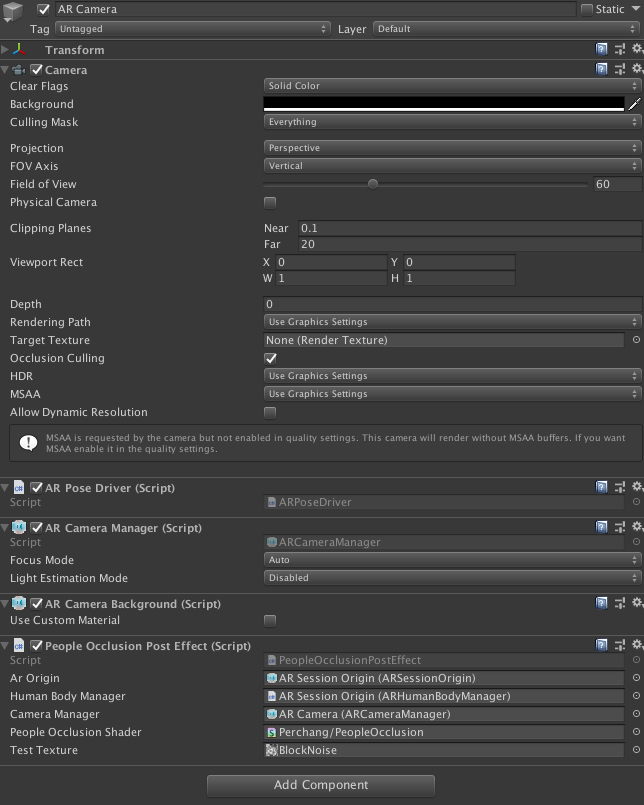ARkit3.0で追加されたPeopleOcclusionを試してみました。
PeopleOcclusionのサンプルを動かそうとしたときにつまづいたので、まとめておきます。
こちらを参考にしたのですが、自分の環境ではうまくいかず、やってみました。
Shaderは素人なので、もし不備やもっとよいいいやり方などあれば、コメントいただけるとうれしいです。
イメージ
ARkit3.0のPeopleOcclusion試してみました。
— 二月のタンクトップ@ARゲーム開発中 (@Raliemon) September 26, 2019
これを使ってゲーム作ろ。 pic.twitter.com/Fv8GE5RBa5
環境
Unity 2019.2.3.f1
Version 11.0 beta
iPhone Xs (Xrでも動作しました)
iOS 13.0
他環境で検証していないため、動かない場合があるかもしれないです。
ARFundationの導入方法
Package Managerより下記2つをインストールします。
・AR Foundation
・ARKit XR Plugin
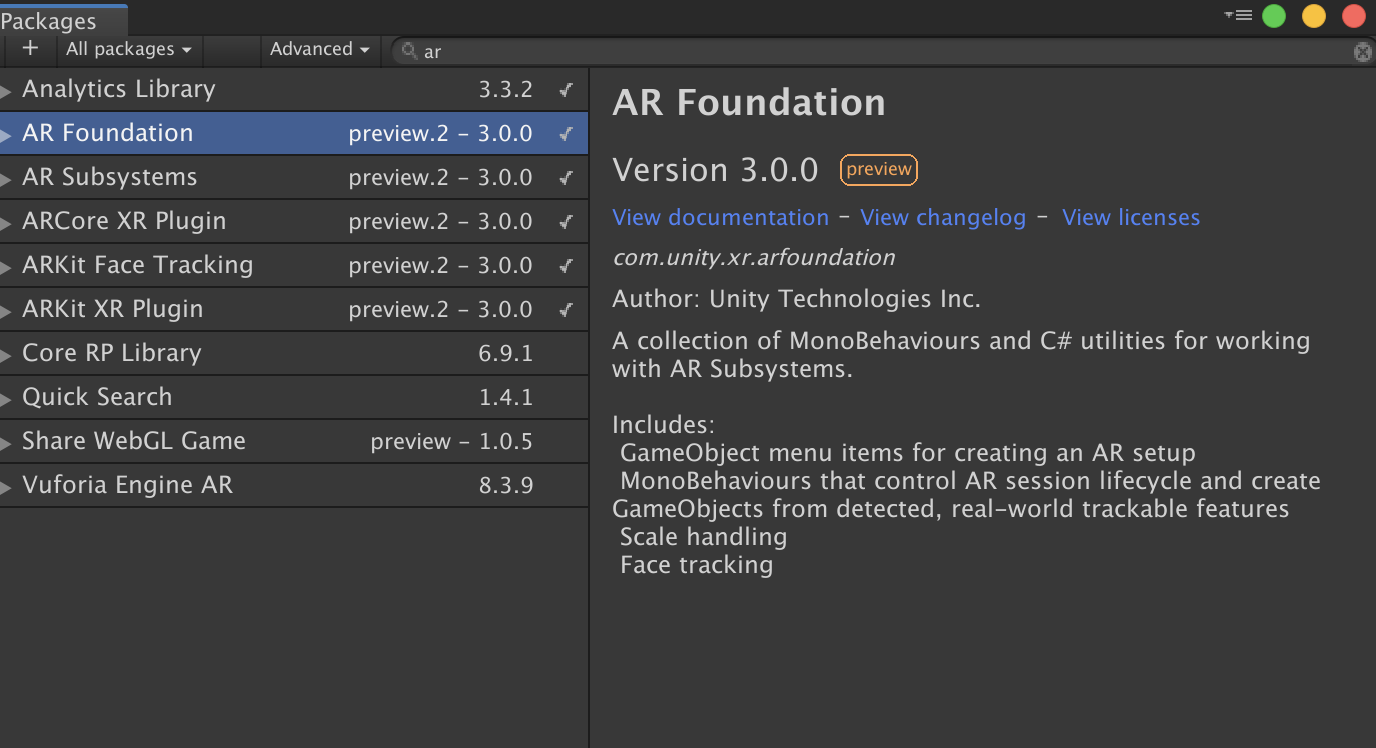
PeopleOcclusion実装方法
1.Unity上でシーンを作成
MainCameraを削除します。
2.GameObject>XRより下記2つを追加
・AR Session
・AR SessionOrigin(こちらのカメラオブジェクトは配置されています)
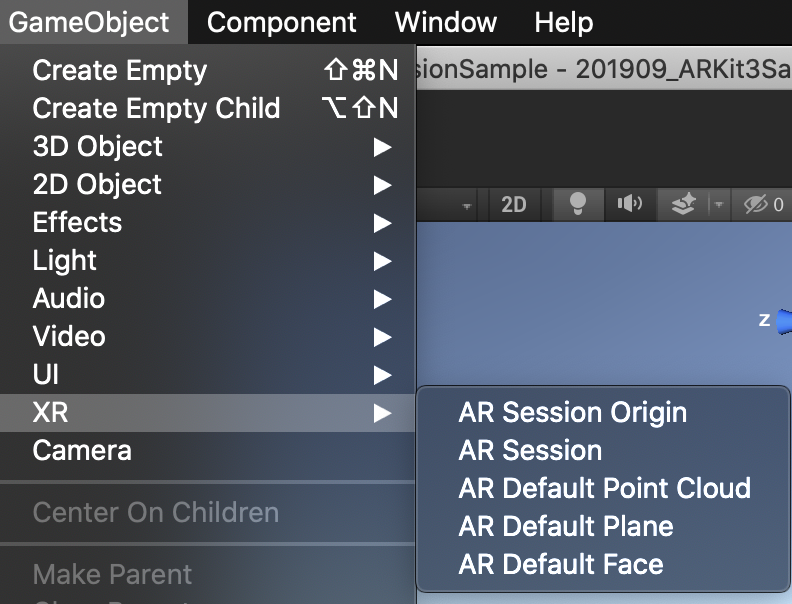
3.AR Sessionはこんな感じ
4.AR SessionOriginオブジェクトにAR Human Body Managerを追加
画像のように各項目を設定する。
※現状Human Segmentation Stencil ModeとHuman Segmentation Depth Modeはこの組み合わせじゃないと失敗しました。
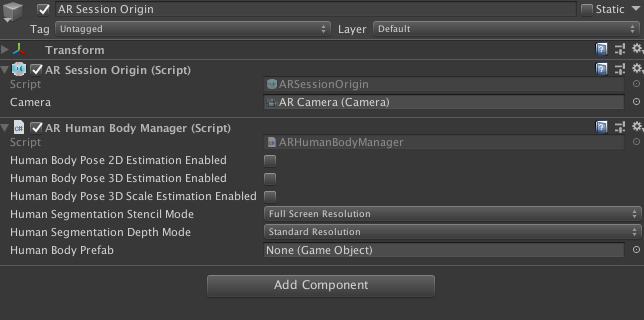
5.AR CameraにPeopleOcclusionPostEffectを追加
※PeopleOcclusionPostEffectスクリプトとPeopleOcclusionシェーダーは後述。
※textTextureのテクスチャーはお好きなのを用意してください。
6.ビルド
ビルドして完成です。
これでLandScape/Portrait両方対応できているかと思います。
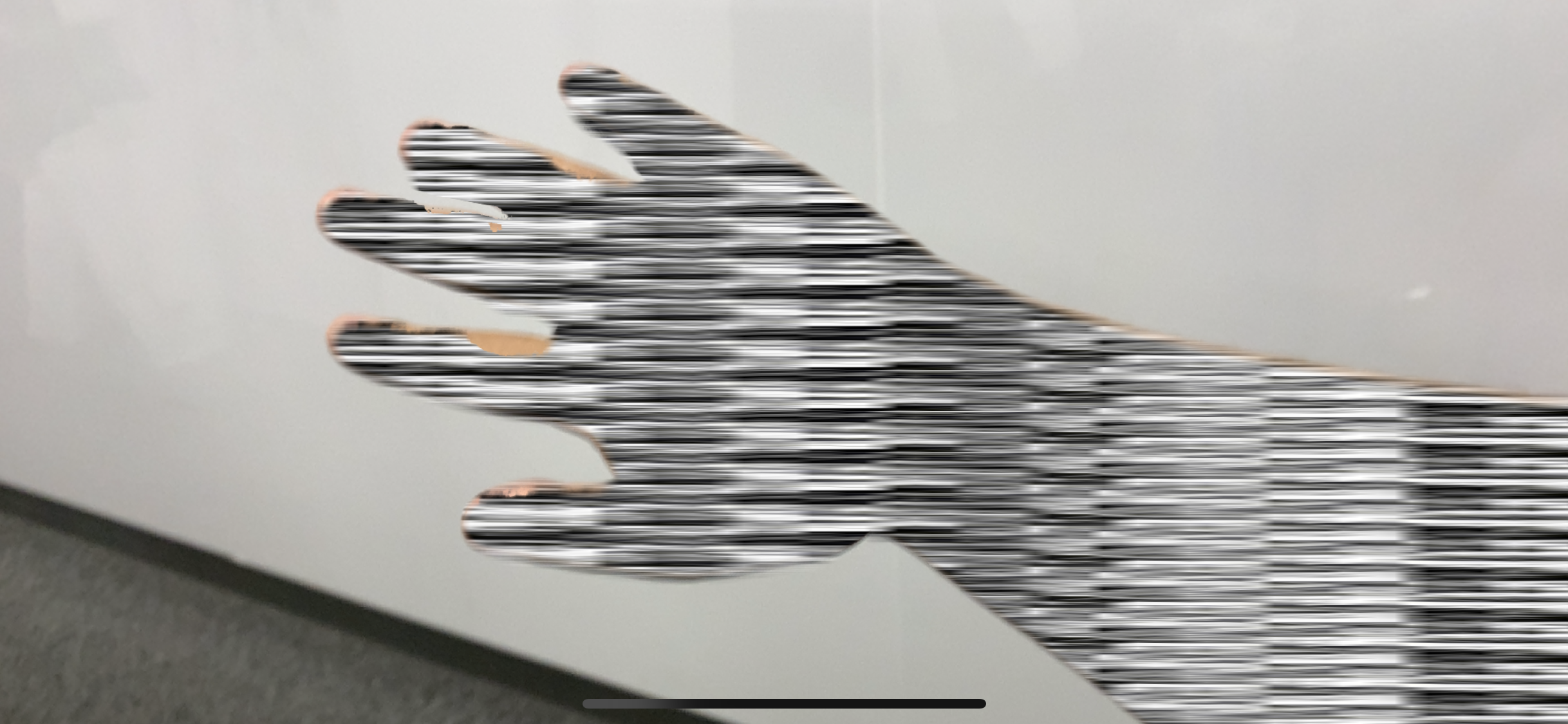
7.スクリプトとシェーダーのサンプル
using UnityEngine;
using System;
using Unity.Collections;
using Unity.Collections.LowLevel.Unsafe;
using UnityEngine.XR.ARFoundation;
using UnityEngine.XR.ARSubsystems;
[RequireComponent(typeof(ARCameraManager))]
public class PeopleOcclusionPostEffect : MonoBehaviour
{
[SerializeField] private ARSessionOrigin m_arOrigin = null;
[SerializeField] private ARHumanBodyManager m_humanBodyManager = null;
[SerializeField] private ARCameraManager m_cameraManager = null;
[SerializeField] private Shader m_peopleOcclusionShader = null;
[SerializeField] Texture2D testTexture;
private Texture2D m_cameraFeedTexture = null;
private Material m_material = null;
void Awake()
{
m_material = new Material(m_peopleOcclusionShader);
GetComponent<Camera>().depthTextureMode |= DepthTextureMode.Depth;
}
private void OnEnable()
{
m_cameraManager.frameReceived += OnCameraFrameReceived;
}
private void OnDisable()
{
m_cameraManager.frameReceived -= OnCameraFrameReceived;
}
void OnRenderImage(RenderTexture source, RenderTexture destination)
{
if(PeopleOcclusionSupported())
{
if(m_cameraFeedTexture != null)
{
m_material.SetFloat("_UVMultiplierLandScape", CalculateUVMultiplierLandScape(m_cameraFeedTexture));
m_material.SetFloat("_UVMultiplierPortrait", CalculateUVMultiplierPortrait(m_cameraFeedTexture));
}
if(Input.deviceOrientation == DeviceOrientation.LandscapeRight)
{
m_material.SetFloat("_UVFlip", 0);
m_material.SetInt("_ONWIDE", 1);
}
else if(Input.deviceOrientation == DeviceOrientation.LandscapeLeft)
{
m_material.SetFloat("_UVFlip", 1);
m_material.SetInt("_ONWIDE", 1);
}
else
{
m_material.SetInt("_ONWIDE", 0);
}
m_material.SetTexture("_OcclusionDepth", m_humanBodyManager.humanDepthTexture);
m_material.SetTexture("_OcclusionStencil", m_humanBodyManager.humanStencilTexture);
// m_material.SetFloat("_ARWorldScale", 1f/m_arOrigin.transform.localScale.x);
Graphics.Blit(source, destination, m_material);
}
else
{
Graphics.Blit(source, destination);
}
}
private void OnCameraFrameReceived(ARCameraFrameEventArgs eventArgs)
{
if(PeopleOcclusionSupported())
{
RefreshCameraFeedTexture();
}
}
private bool PeopleOcclusionSupported()
{
return m_humanBodyManager.subsystem != null && m_humanBodyManager.humanDepthTexture != null && m_humanBodyManager.humanStencilTexture != null;
}
private void RefreshCameraFeedTexture()
{
XRCameraImage cameraImage;
m_cameraManager.TryGetLatestImage(out cameraImage);
if (m_cameraFeedTexture == null || m_cameraFeedTexture.width != cameraImage.width || m_cameraFeedTexture.height != cameraImage.height)
{
m_cameraFeedTexture = new Texture2D(cameraImage.width, cameraImage.height, TextureFormat.RGBA32, false);
// m_cameraFeedTexture = new Texture2D(Screen.width, Screen.height, TextureFormat.RGBA32, false);
}
CameraImageTransformation imageTransformation = Input.deviceOrientation == DeviceOrientation.LandscapeRight ? CameraImageTransformation.MirrorY : CameraImageTransformation.MirrorX;
XRCameraImageConversionParams conversionParams = new XRCameraImageConversionParams(cameraImage, TextureFormat.RGBA32, imageTransformation);
NativeArray<byte> rawTextureData = m_cameraFeedTexture.GetRawTextureData<byte>();
try
{
unsafe
{
cameraImage.Convert(conversionParams, new IntPtr(rawTextureData.GetUnsafePtr()), rawTextureData.Length);
}
}
finally
{
cameraImage.Dispose();
}
m_cameraFeedTexture.Apply();
m_material.SetTexture("_CameraFeed", testTexture);
}
private float CalculateUVMultiplierLandScape(Texture2D cameraTexture)
{
float screenAspect = (float)Screen.width / (float)Screen.height;
float cameraTextureAspect = (float)cameraTexture.width / (float)cameraTexture.height;
return screenAspect / cameraTextureAspect;
}
private float CalculateUVMultiplierPortrait(Texture2D cameraTexture)
{
float screenAspect = (float)Screen.height / (float)Screen.width;
float cameraTextureAspect = (float)cameraTexture.width / (float)cameraTexture.height;
return screenAspect / cameraTextureAspect;
}
}
Shader "Perchang/PeopleOcclusion"
{
Properties
{
_MainTex ("Texture", 2D) = "white" {}
_CameraFeed ("Texture", 2D) = "white" {}
_OcclusionDepth ("Texture", 2D) = "white" {}
_OcclusionStencil ("Texture", 2D) = "white" {}
_UVMultiplierLandScape ("UV MultiplerLandScape", Float) = 0.0
_UVMultiplierPortrait ("UV MultiplerPortrait", Float) = 0.0
_UVFlip ("Flip UV", Float) = 0.0
_ONWIDE("Onwide", Int) = 0
}
SubShader
{
// No culling or depth
Cull Off ZWrite Off ZTest Always
Pass
{
CGPROGRAM
#pragma vertex vert
#pragma fragment frag
#include "UnityCG.cginc"
struct appdata
{
float4 vertex : POSITION;
float2 uv : TEXCOORD0;
};
struct v2f
{
float2 uv : TEXCOORD0;
float2 uv1 : TEXCOORD1;
float2 uv2 : TEXCOORD2;
float4 vertex : SV_POSITION;
};
sampler2D _MainTex;
float4 _MainTex_ST;
sampler2D_float _OcclusionDepth;
sampler2D _OcclusionStencil;
sampler2D _CameraFeed;
sampler2D_float _CameraDepthTexture;
float _UVMultiplierLandScape;
float _UVMultiplierPortrait;
float _UVFlip;
int _ONWIDE;
v2f vert (appdata v)
{
v2f o;
o.vertex = UnityObjectToClipPos(v.vertex);
o.uv = v.uv;
if(_ONWIDE == 1)
{
o.uv1 = float2(v.uv.x, (1.0 - (_UVMultiplierLandScape * 0.5f)) + (v.uv.y / _UVMultiplierLandScape));
o.uv2 = float2(lerp(1.0 - o.uv1.x, o.uv1.x, _UVFlip), lerp(o.uv1.y, 1.0 - o.uv1.y, _UVFlip));
}
else
{
o.uv1 = float2((1.0 - (_UVMultiplierPortrait * 0.5f)) + (v.uv.x / _UVMultiplierPortrait), v.uv.y);
o.uv2 = float2(lerp(1.0 - o.uv1.y, o.uv1.y, 0), lerp(o.uv1.x, 1.0 - o.uv1.x, 1));
}
return o;
}
fixed4 frag (v2f i) : SV_Target
{
fixed4 col = tex2D(_MainTex, i.uv);
fixed4 cameraFeedCol = tex2D(_CameraFeed, i.uv1 * _Time);
float sceneDepth = LinearEyeDepth(SAMPLE_DEPTH_TEXTURE(_CameraDepthTexture, i.uv));
float4 stencilCol = tex2D(_OcclusionStencil, i.uv2);
float occlusionDepth = tex2D(_OcclusionDepth, i.uv2) * 0.625; //0.625 hack occlusion depth based on real world observation
float showOccluder = step(occlusionDepth, sceneDepth) * stencilCol.r; // 1 if (depth >= ocluderDepth && stencil)
return lerp(col, cameraFeedCol, showOccluder);
}
ENDCG
}
}
}

